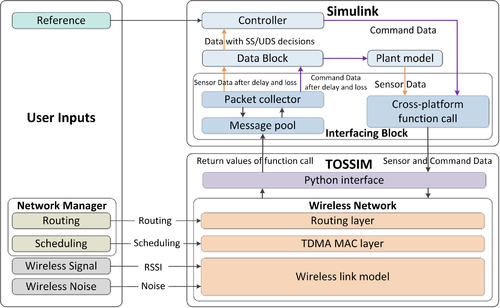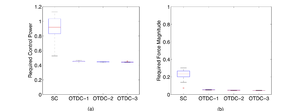WCPS: Wireless Cyber-Physical Simulator
End-user's Tutorial on using WCPS: The Wireless Cyber-Physical Simulator
WCPS is design for, but not limited to, realistic Wireless Structural Control simulations. The efficient integration of Simulink and TOSSIM has made WCPS an ideal choice for realistic wireless control simulations. The following tutorial introduces how to install and configure MATLAB, TinyOS, and PYTHON environments, as well as the WCPS framework. The tutorial herein is specifically organized for end-users who do not do much development but instead trying to do wireless control simulations with Simulink and TOSSIM. A more advanced tutorial for developers can be found [here].
Change Log
- Release: March 10, 2013, WCPS v0.1.1 released.
- Tutorial: March 09, 2013, WSC Examples from a structural perspective.
WCPS Principle
As shown in the architecture illustrated in Fig. 2, WCPS simulates the feedback control loop of the control system as follows. Sensor data is generated from structural models. Through a cross-platform function call from Simulink, sensor data is injected to the corresponding wireless sensors in TOSSIM. Following the routes and transmission schedule calculated by the network manager module, TOSSIM simulates the end-to-end wireless communication of the sensor data packets from the sensors to the base station, and then return the packet delay and loss to the Interfacing Block in Simulink through the Python interface. The Packet Collector module then to extracts packet delivery information(the delay and loss)from the message pool of returned values in Simulink. Sensor data and their loss and delay are then provided to the Data Block, which then feed the sensor data to the controller at the right time based on the packet delay (if the packet is not lost). WCPS utilizes basic API (e.g., the dos, UNIX command) of MATLAB to do cross-platform function calls. In TOSSIM, we re-implement a printf method in TinyOS to send TOSSIM simulation results to the Interfacing Block.
User inputs to WCPS includes excitation signals to the structure (e.g., acceleration caused by earthquakes) and wireless traces used as input to TOSSIM. Excitation signal of the structure is provided to the structure models in the format of MAT files. The scheduler module calculates transmission schedules. Networking schedule is then deployed into the MAC layer code of wireless nodes and becomes effective after a TinyOS compilation. The TDMA MAC layer in WCPS is developed based on the MAC Layer Architecture (MLA) library [17] and further adapted for TOSSIM under TinyOS 2.1.1. Received Signal Strength Indication( RSSI) and wireless noises traces are collected from real-world environments and provided to the wireless model [18] used by TOSSIM for realistic wireless network simulations. As shown in Fig. 2, the interfaces between the Simulink model and TOSSIM are encapsulated as two MATLAB embedded functions in Simulink: the Interfacing Block and the Data Block. The Interfacing Block extracts delay and loss information from TOSSIM messages, and the Data Block decides what data will be used for discrete control during each sampling period. The federated architecture of WCPS provides great flexibilities to incorporate different structural models and implement alternative scheduling-control approaches.
WCPS Capability
Fig. 13 shows the end-to-end packet delivery ratio of the wireless network. The end-to-end delivery ratio means the fraction of packets from the sensors that are successfully delivered to the controller. As shown in Fig. 13 Sensor 1 has the lowest delivery ratio because it has a 2-hop route to the controller. Recall that OTDC-1 does not perform any retransmission, while OTDC-2 and OTDC-3 performs retransmit each packet once and twice, respectively. Under OTDC-1 Sensors 1 and 4 have delivery ratios of 70% and over 95%, respectively. As expected more retransmissions improve the deliver ratios of all sensors at the cost of longer delays as described earlier.
Wireless Structural Control (WSC) systems are a representative class of cyber-physical systems that have the promise to protect our civil infrastructure in the event of earthquake and other natural disasters. To develop WSC systems it is critical to capture both the cyber aspects (wireless communication and control) and the physical aspects (structural dynamics) through realistic and holistic simulations. We have developed the Wireless Cyber-Physical Simulator (WCPS) that integrates a high-fidelity wireless simulator (TOSSIM) and a standard control system simulator (Simulink). With WCPS, we performed two case studies on structural control systems. Each case study combines a realistic structural model and wireless simulations driven by traces collected from real-world deployments. Our case studies leads to three important insights. First, there exist complex tradeoffs among data synchronization, sensing delay, and network reliability under realistic wireless structural control settings. Second, a realistic, integrated wireless control simulator like WCPS is critical in exploring the design tradeoffs in wireless control design. Finally, a control-scheduling co-design approach is effective in wireless control design. In both case studies the integration of a contant-delay control design and a scheduling scheme achieving data synchronization lead to substantial improvement in control performance when compared to a traditional control design. Our cyber-physical simulation methodology and scheduling-control co-design approaches presented in this work not only represent a promising step toward smart civil infrastructure, but also provide useful insights and tools that can be generalized to other cyber-physical systems employing wireless control.
Live Example
Installation
Install TinyOS
WCPS is implemented and tested on MacOS X (snowleopard), Windows XP, and Windows 7. Current release of WCPS is under TinyOS 2.1.1, which can be installed following the two methods.
- Follow the TinyOS official tutorial on installation of TinyOS for your specific platform: Link
- Directly download the pre-tested TinyOS 2.1.1 image from here: [under construction Cygwin] TinyOS2.1.1 for SnowLeopard and later versions.
Install Mac Layer Architecture(MLA)
- Follow the instructions here: Install MLA.
Install MATLAB and Simulink
If you already have MATLAB MATLAB 7.11.0.584 (2010b) or later version, skip this step. Otherwise, follow the tutorial here: install MATLAB
Install Python
If you already have Python 2.7.2 or later version installed, skip this step. Otherwise, follow the manual here: install Python
Installation Check
To test if TinyOS, Python and WCPS were configured correctly, pleas read ahead and do the following example.
A Simple Example with WCPS
Wireless Network Setup
- Makefile
"Makefile" takes advantage of the fact that it's not necessary to recompile all the project files that has not been changed. To have the "Makefile" for our project, copy the code below into a txt file and save as "Makefile" without any suffix.
- TestNetwork.h
"TestNetwork.h" defines necessary message structures for the wireless communication. Copy the code below into a txt file and save as "TestNetwork.h".
- TestNetworkAppC.nc
"TestNetworkAppC.nc" connects claimed application interfaces to interfaces that are defined in the hardware librare. Copy the code below into a txt file and save as "TestNetworkAppC.nc".
- TestNetworkC.nc
"TestNetworkC.nc" Implements send/receive functionality of a wireless node. Copy the code below into a txt file and save as "TestNetworkC.nc".
- tossim-call.py
"tossim-call.py" configures TOSSIM network and does packet injection into the Tossim network. Copy the code below into a txt file and save as "tossim-call.py".
- Wireless traces
- Make
To run the network simulation above, we need wireless RSSI (strength of the wireless communication signal) and wireless Noise for Tossim to build Signal to Noise Ratio (SNR) model. Two options to do are:
1) Use the provided RSSI and noise traces for test purposes.
2) Use the code [rssi.zip] to collect the RSSI values and use code [noise.zip] to collect the wireless noise traces.
Example Test
And you are ready to go for the wireless network setup.
Get Support
- TinyOS and TOSSIM: Bo Li: boli@seas.wustl.edu
- Simulink Models: Zhuoxiong Sun: SUN152@purdue.edu
Put all the above files into the same folder, prompt a terminal (or a Cygwin window), and: 1. In the terminal, Make micaz sim and hit return 2. In the terminal ./tossim-call.py
References
- B. Li, Z. Sun, K. Mechitov, G. Hackmann, C. Lu, S. Dyke, G. Agha and B. Spencer, "Realistic Case Studies of Wireless Structural Control," ACM/IEEE International Conference on Cyber-Physical Systems (ICCPS'13), April 2013.
- Z. Sun, B. Li, D. Dyke, and C. Lu. "A novel data utilization and control strategy for wireless structural control systems with tdma network," In Proc. ASCE IWCCE 2013.
- Z. Sun, B. Li, S.J. Dyke and C. Lu, "Evaluation of Performances of Structural Control Benchmark Problem with Time Delays from Wireless Sensor Network," Joint Conference of the Engineering Mechanics Institute and ASCE Joint Specialty Conference on Probabilistic Mechanics and Structural Reliability (EMI/PMC'12), June 2012.
- H. Lee, A. Cerpa, and P. Levis. Improving wireless simulation through noise modeling. In IPSN, 2007.
- P. Levis, N. Lee, M. Welsh, and D. Culler. Tossim: Accurate and scalable simulation of entire tinyos applications. In Sensys, 2003.

